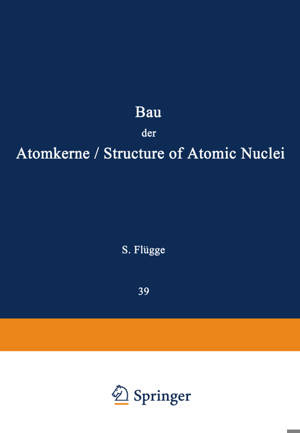
- Afhalen na 1 uur in een winkel met voorraad
- Gratis thuislevering in België vanaf € 30
- Ruim aanbod met 7 miljoen producten
- Afhalen na 1 uur in een winkel met voorraad
- Gratis thuislevering in België vanaf € 30
- Ruim aanbod met 7 miljoen producten
Zoeken
Structure of Atomic Nuclei / Bau Der Atomkerne
S Flügge
Paperback | Engels | Handbuch der Physik Encyclopedia of Physics | Kernphysik / Nuclear Physics | nr. 8
€ 162,45
+ 324 punten
Omschrijving
243 number n and orbital angular momentum 1, but also a total angular momentum 1 f = 1 ± !. This modification lead to striking successes for the model. Almost without exception, the ground state spins of odd nuclei were found to be cor- rectly predicted. Furthermore several other features of nuclei such as the occur- rence of isomeric states and the values of magnetic dipole moments were explained, at least qualitatively. However the model completely failed to explain the large values of observed electric quadrupole moments and certain regularities in nuclear spectra, especially of rare earth nuclei. 4. 1950-1953. The emphatic success of the shell-model modified by a spin- orbit force gave the necessary confidence and incentive to physicists to apply the model in detail to individual nuclei. Guided by parallel calculations in atomic spectroscopy, considerable effort was devoted to computing spectra of levels of nuclear systems with the so-called "Intermediate Coupling Model" in which the independent particle motion is considered to be perturbed by central particle- particle interactions and spin-orbit forces. Computational labour restricts such calculations to nuclei near closed shells, say within four particles or holes of closed shells. This explains why only light nuclei (A
Specificaties
Betrokkenen
- Auteur(s):
- Uitgeverij:
Inhoud
- Aantal bladzijden:
- 566
- Taal:
- Engels
- Reeks:
- Reeksnummer:
- nr. 8
Eigenschappen
- Productcode (EAN):
- 9783642458743
- Verschijningsdatum:
- 15/04/2014
- Uitvoering:
- Paperback
- Formaat:
- Trade paperback (VS)
- Afmetingen:
- 170 mm x 244 mm
- Gewicht:
- 907 g

Alleen bij Standaard Boekhandel
+ 324 punten op je klantenkaart van Standaard Boekhandel
Beoordelingen
We publiceren alleen reviews die voldoen aan de voorwaarden voor reviews. Bekijk onze voorwaarden voor reviews.








